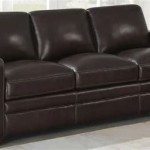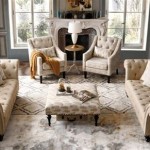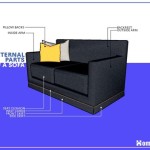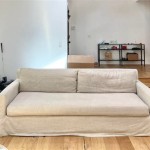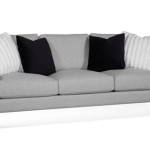```html
How To Style Cushions On A Corner Sofa
Styling cushions on a corner sofa is a crucial element in interior design, impacting the overall aesthetic and comfort of a living space. A well-arranged collection of cushions can transform a corner sofa from a functional seating arrangement into a focal point of the room, reflecting personal style and enhancing the room's atmosphere. This article provides a comprehensive guide to effectively styling cushions on a corner sofa, covering essential principles and practical techniques.
Understanding the Corner Sofa's Configuration
Before embarking on cushion selection and arrangement, it is essential to understand the specific configuration of the corner sofa. Corner sofas come in various designs, including L-shaped, U-shaped, and sectional configurations. The shape and size of the sofa dictate the number of cushions needed and how they can be arranged to optimize visual appeal and comfort.
An L-shaped sofa typically features two sections joined at a right angle. This configuration lends itself to a balanced arrangement of cushions, with a larger grouping on the longer section and a smaller grouping on the shorter section. U-shaped sofas, with their three sections, provide more opportunities for creating symmetrical or asymmetrical cushion arrangements. Sectional sofas, being modular, allow for even greater flexibility in cushion styling, as the sections can be rearranged to create different layouts.
Assessing the sofa's existing features, such as its color, texture, and material, is also crucial. These factors will influence the selection of cushion covers and patterns to ensure a cohesive and visually harmonious design. Consider whether the sofa has a high back or a low back, as this will affect the size and type of cushions that will work best.
Selecting the Right Cushions: Size, Shape, and Texture
The selection of cushions is a vital step in the styling process. Factors to consider include size, shape, and texture. A variety of sizes and shapes adds depth and visual interest to the arrangement, while different textures can enhance the tactile experience and contribute to the overall aesthetic.
Regarding size, a mix of large, medium, and small cushions is generally recommended. Large cushions, typically ranging from 20 to 24 inches, serve as the foundation of the arrangement. They are placed towards the back of the sofa to provide support and visual anchor. Medium-sized cushions, around 18 inches, are placed in front of the larger cushions, adding another layer of comfort and visual appeal. Small cushions, such as lumbar or bolster cushions, act as accent pieces and can be placed at the front of the arrangement to add a touch of personality and detail.
Different shapes can also enhance the visual interest of the cushion arrangement. Square cushions are a classic choice and provide a clean, symmetrical look. Rectangular or lumbar cushions offer ergonomic support and can be strategically placed to enhance comfort. Round or bolster cushions add a softer, more organic touch to the arrangement. Experimenting with different shapes can create a more dynamic and visually appealing arrangement.
Texture plays a crucial role in adding depth and dimension to the cushion arrangement. Different textures can create a sense of warmth, luxury, or playfulness, depending on the desired aesthetic. Consider incorporating cushions with varying textures such as velvet, linen, cotton, faux fur, or knitted fabrics. Mixing smooth and textured cushions can create a tactile experience that enhances the overall comfort and visual appeal of the sofa.
Color Palette and Pattern Mixing
The color palette and pattern mixing are key elements in creating a cohesive and visually appealing cushion arrangement. The colors and patterns chosen should complement the sofa's color, the room's decor, and personal preferences.
When selecting a color palette, consider the overall style of the room. For a neutral and calming aesthetic, opt for a monochromatic color scheme or a palette of muted tones. For a more vibrant and energetic look, incorporate bolder colors and contrasting shades. A general rule of thumb is to choose a base color that complements the sofa's color and then introduce two or three accent colors through the cushions. These accent colors can be used to create pops of color and visual interest.
Pattern mixing can add depth and personality to the cushion arrangement. When mixing patterns, it is important to consider the scale and style of the patterns. A good approach is to choose one dominant pattern and then incorporate smaller-scale patterns that complement it. For example, a large floral print can be paired with a smaller geometric pattern or a solid color cushion with a subtle texture. Avoid mixing too many different patterns, as this can create a cluttered and overwhelming look. Aim for a balance between patterned and solid cushions to create a visually harmonious arrangement.
Consider the existing patterns in the room, such as those on the curtains, rugs, or artwork. The cushion patterns should complement these existing patterns to create a cohesive and unified design. For example, if the curtains have a floral pattern, consider incorporating cushions with similar floral motifs or patterns in complementary colors.
Arrangement Techniques for Optimal Visual Appeal
The way cushions are arranged on the corner sofa is just as important as the selection of cushions themselves. Experimenting with different arrangement techniques can help achieve the desired aesthetic and maximize the visual impact of the cushion collection.
One common arrangement technique is the symmetrical approach. In this approach, the cushions are arranged in a balanced and mirrored fashion. This creates a sense of order and formality, which can be particularly effective in more traditional or formal living spaces. To achieve a symmetrical arrangement, place the largest cushions at the back of the sofa, followed by medium-sized cushions, and then small accent cushions at the front. Mirror the arrangement on both sides of the corner section to create a balanced look.
Asymmetrical arrangements offer a more relaxed and informal aesthetic. In this approach, the cushions are arranged in a more random and organic fashion, creating a sense of movement and visual interest. To achieve an asymmetrical arrangement, start by placing the largest cushions at the back of the sofa and then gradually add smaller cushions in a less structured pattern. Experiment with overlapping cushions and varying the placement to create a dynamic and visually engaging arrangement. Group cushions in odd numbers (e.g., three or five) to create a more visually appealing composition.
Another approach is to create a focal point within the cushion arrangement. This can be achieved by placing a statement cushion, such as one with a bold pattern or texture, in a prominent position. This statement cushion will draw the eye and serve as the anchor of the arrangement. Surround the statement cushion with smaller cushions in complementary colors and textures to create a balanced and visually harmonious composition.
Consider the layering effect when arranging cushions. Layering cushions of different sizes and shapes can create depth and dimension, enhancing the overall visual appeal of the arrangement. Overlapping cushions can also create a more relaxed and inviting look. Experiment with different layering techniques to find the arrangement that best suits the style and configuration of the corner sofa.
Practical Considerations: Comfort and Functionality
While aesthetics are important, it is essential to consider the comfort and functionality of the cushion arrangement. The cushions should not only look good but also provide adequate support and comfort for lounging and relaxation.
Ensure that the cushions are not too bulky or overwhelming, as this can make the sofa uncomfortable to sit on. Choose cushions that are the right size and density to provide adequate support without taking up too much space. Avoid placing too many cushions on the sofa, as this can make it difficult to move around and find a comfortable position.
Consider the placement of cushions in relation to the arms and back of the sofa. Cushions should be positioned to provide support for the back and arms, allowing for comfortable lounging. Place lumbar cushions strategically to provide lower back support. Arrange cushions in a way that allows for easy access to the seating area and avoids obstructing the view.
Choose cushion covers that are durable and easy to clean. Corner sofas are often used frequently, so the cushions will be subject to wear and tear. Opt for fabrics that are resistant to stains and easy to maintain. Consider using removable cushion covers that can be easily washed or dry-cleaned. This will help keep the cushions looking fresh and clean and extend their lifespan.
Regularly fluff and rearrange the cushions to maintain their shape and appearance. Over time, cushions can become flattened and lose their shape. Fluffing the cushions regularly will help restore their shape and fullness. Rearranging the cushions periodically can also help prevent them from becoming worn in certain spots.
By carefully considering the configuration of the corner sofa, selecting the right cushions, and employing effective arrangement techniques, it is possible to transform a corner sofa into a stylish and comfortable focal point of any living space. Remember to balance aesthetics with practicality to create a cushion arrangement that is both visually appealing and functional.
```
7 Best Ideas To Decorate Cushions On A Corner Sofa

How Many Cushions Should You Have On Your Sofa Furn Com

How To Arrange Throw Pillows On A Couch

The Right Way To Arrange Cushions On A Corner Sofa

How To Style Cushions

Corner Sofa Styling Tips Mood Boards Furniture Blog

How To Arrange Cushions On A Sofa For Designer Finish Voyage Maison

How To Style A Corner Sofa Design Ideas Plumbs

How To Arrange Sofa Cushions Homescapes

How To Style Your Throw Pillows

